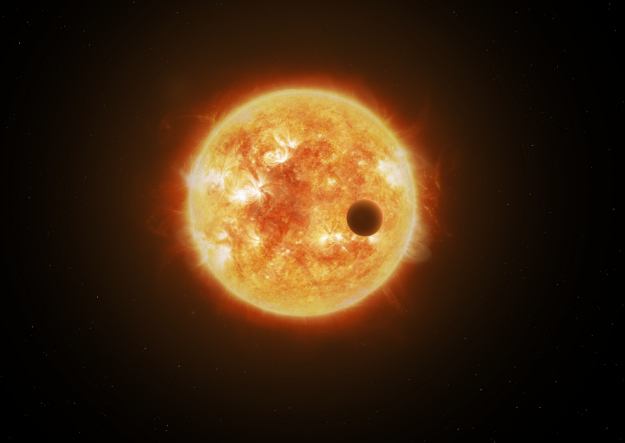Senior Researcher Pierre-Olivier Lagage discusses how, after the detection of exoplanets, the characterisation of their atmosphere is the next step to understanding alien worlds
Extra-solar planet (or ‘exoplanet’) science is a fast-developing field. Twenty-six years after the discovery of the first exoplanet around a main-sequence star by M. Mayor and D. Queloz (1995) who were awarded the Nobel Prize in Physics in 2019, more than 4500 have been detected. Two words can characterise the exoplanet population:
- Ubiquity – most of the stars are orbited by one or several exoplanets.
- Diversity – classes of exoplanets with no equivalent in the Solar System have been discovered, such as hot Jupiters, inflated Jupiters, super-Earths, etc.
The next step to get crucial information on exoplanets is to characterise their atmosphere using spectroscopic observations over a broad wavelength range from the Ultra-Violet to the mid-Infrared. A wealth of information can be extracted from such observations: the presence and abundance of atoms, molecules, ions, hazes and clouds; the vertical and horizontal thermal structures, just to name a few examples. Such information is needed to test and improve the chemistry and dynamics incorporated in the atmospheric models applied to alien worlds. Modelling such systems will enable the exploration of the entire atmospheric parameter space and the study of chemical processes and atmospheric circulation patterns which have no precedent on Earth or other planets in the Solar system. The new acquired knowledge and perspective will ultimately help our understanding of our own planet, the Earth.
A key player launched by the end of the year: The James Webb Space Telescope
A key player to characterise the exoplanet atmospheres is going to be launched before the end of the year by an Ariane rocket: The James Webb Space Telescope (JWST), a NASA led mission with participation from Europe, through ESA, and Canada. With a 6.5 m diameter primary mirror, the JWST will be the largest telescope in space. Combining a large collecting area with a broad range of wavelengths (0.6 – 28 μm) makes the JWST a unique facility to characterise exoplanet atmospheres and we expect that about 25% of the observing time of this multi-purpose observatory will be devoted to exoplanet observations.
The most used method to characterise an exoplanet atmosphere is the so-called transit method. When a planet passes between us and the star, we can observe a faint decrease in brightness. This is because the planet is preventing some of the light from the star from reaching us. If the exoplanet has an atmosphere, the molecules in the atmosphere can also absorb some of the starlight in specific wavelength bands. Most of the chemical species expected in the atmosphere of exoplanets (H2O, CO, CO2, NH3, SiO, O3, PH3, CH4, Na, K, etc.,) have signatures in the wavelength range covered by the JWST.
Of particular interest will be the study of rocky exoplanets with questions such as:
- Do they have an atmosphere?
- Are their atmospheric composition and temperature indicative of an environment that could host life?
- And ultimately: Are there signatures of life?
Prime rocky targets to be observed during the first year of JWST operation
Rocky planets orbiting dwarf stars are ideal targets for JWST because of their favourable star-planet contrast, and the short orbital periods of the inner planets, making transits more probable.
One target of prime interest is the Trappist 1 system. The system hosts seven Earth-sized, temperate exoplanets, that orbit a nearby (≃ 40 light-years) ultra-cool dwarf star (Gillon et. al., 2017). Considering their transiting nature, combined with the infrared brightness and the Jupiter-like size of their host star, these planets are among the most promising candidates for the first detailed study of Earth-sized temperate exoplanets with the JWST. Five observing programmes have been accepted to study the system.
“The next mission to characterise exoplanet atmospheres, the ESA led Ariel mission, is already in development.”
Another extremely interesting target is LHS3844 b; it has been detected by the TESS mission, which is devoted to supplying JWST with golden targets. The rocky exoplanet has no or a very thin atmosphere (Kreidberg et al. 2019) giving the perspective for the JWST to characterise for the first time the surface of a rocky planet orbiting a star other than the Sun.
A last example of a target is K2-141b, which belongs to the so-called lava exoplanets class; these exoplanets have bulk densities consistent with terrestrial composition, but dayside temperatures hot enough to melt and vaporise rock. A ‘mineral’ atmosphere is expected to be observed.
Challenging observations
Characterisation of exoplanet atmospheres is hampered by a major difficulty: The tiny spectro-photometric variations induced by the planet of the order of 10-4 to 10-5, making spectroscopic observations of the atmospheres an extremely challenging undertaking. In the framework of the H2020 RIA ExoplANETS-A Programme, we have developed a novel data-driven method to remove systematics from spectroscopic data.
If the observations during the first year (cycle 1) are successful, then even more ambitious programmes could be developed for the next cycles of JWST observations. The JWST will be in operation for at least five years and up to ten years or more. The detection of exoplanets has been full of surprises, and we can expect the characterisation of their atmosphere to also bring its share of surprises!
Perspectives
The next mission to characterise exoplanet atmospheres, the ESA led Ariel mission, is already in development. This mission, to be launched in 2029, is entirely devoted to the characterisation of exoplanets atmospheres and will bring a statistical approach; indeed, about 1,000 exoplanet atmospheres will be studied (Tinetti et al. 2021).
References
Gillon M. et al., 2017. Nature 542, 456.
Kreidberg L. et. al. 2019, Nature 573,87 ; arXiv: 1908.06834.
Mayor M. and Queloz D. 1995, Nature 378, 355 – 359, 1995
Tinetti G. et al. 2021, arXiv:2104.04824v1
Please note: This is a commercial profile
© 2019. This work is licensed under CC-BY-NC-ND.











